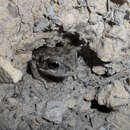Description
provided by AmphibiaWeb articles
This toad does not have cranial crests; interorbital space a little broader than the upper eyelid; tympanum distinct, round, its diameter two third that of eye; first and second fingers subequal; toes with single subarticular tubercles; a tarsal spinulated ridge; the parotid gland is longer than broad; a distinct tibial gland is present. Color: Dorsum light gray or olive to almost black, with dark mottling or gray to dark reticulation; upper lip cream. Ventrum dirty white, dark mottling on throat, 3 dark transverse bands on anterior aspect of forearm. Tips of digits dark brown.This toad is the most common amphibian in the Indus Valley, however increasing use of chemicals in agricultural fields is taking its toll. Khan, M. S. 1965. A normal table of Bufo stomaticus (Bufo melanostictus). Biologia, 11:1-39. ----1968 a. Morphogenesis of digestive tract of Bufo stomaticus. Pakistan J. Sci. Res.,20:93-106. ----1982 b. Collection, preservation and identification of amphibian eggs from the plains of Pakistan. Pakistan. J. Zool., 14:241-243. ----1991 a. Morphoanatomical specialization of the buccopharyngeal region of the anuran larvae and its bearing on the mode of larval feeding. Ph.D. diss., University of the Punjab, Lahore, Pakistan. pp. 99. ----2000. Sar Zameen-a-Pakistan kay Maindak aur Khazinday (Amphibians and reptiles of Pakistan). Urdu Science board, 299-Upper Mall, Lahore. ---- and S. A. Mufti, 1994a. Oral disc morphology of amphibian tadpole and its functional correlates. Pakistan J. Zool., 26:25-30. ----and----1994b. Buccopharyngeal specializations of tadpole of Bufo stomaticus and its ecological correlates. Pakistan J. Zool.,26:285-292. For references in the text, see here
- Daniel, J.C. (1963). ''Field guide to the amphibians of Western India, Part 2.'' Journal of the Bombay Natural History Society, 60(3), 690-702.
- Khan, M.S. (1968). ''Amphibian fauna of District Jhang with notes on habits.'' Pakistan Journal of Science, 20, 227-233.
- Khan, M.S. and Mufti, S.A. (1994). ''Buccopharyngeal specializations of tadpole of Bufo stomaticus and its ecological correlates.'' Pakistan Journal of Zoology, 26, 285-292.
- Khan, M.S. and Mufti, S.A. (1994). ''Oral disc morphology of amphibian tadpole and its functional correlates.'' Pakistan Journal of Zoology, 26, 25-30.
Distribution and Habitat
provided by AmphibiaWeb articles
In Pakistan: Widely distributed throughout the Indo-Pakistan subcontinent. It is collected from upper and lower Indus Valleys, Balochistan, from plains to an elevation of 1800 m in the northern and western hilly tracts of Pakistan. Outside Pakistan: from Bangladesh through the Ganges Plain, peninsular India, Afghanistan, Iran, and Muscat.
Life History, Abundance, Activity, and Special Behaviors
provided by AmphibiaWeb articles
Tadpole: Schools of dark tadpoles of this species are a common sight in ponds and puddles in the plains of Punjab and Sindh during monsoons. In the hills the tadpoles are confined to the side pools of torrents. Daniel (1963a) recorded this toad as breeding in pooled water about 90 m away from the sea in Mumbai, India. The tadpole is typically bufonid, with an oval bulging body, weak tail, high dorsal, and narrower ventral fin (see Figure 3A). The oral disc is anteroventral with a 2(2)/3 labial tooth row formula; the beak is finely serrated with lateral oral papillae (see Figure 3B). The body and fins of the tadpole are speckled with light brown (Khan 1968a; Khan and Mufti, 1994a,b). Total length of tadpole 30-31 mm, tail 20 mm. The gregarious habit of this tadpole continues up to the 36th Stage of development (Khan 1965), later the tadpole becomes solitary and when disturbed takes to the deep water (Khan 1991a; Khan and Mufti 1994b).
Life History, Abundance, Activity, and Special Behaviors
provided by AmphibiaWeb articles
Run off from chemicals used as fertilizers and pesticides against crop pests is causing death and deformities in tadpoles. Mortality due to increasing traffic is high. The spray of insecticides on crops is causing havoc to the population of this toad, by being directly getting the spray, and by eating spray-killed insects and their larvae. Increasing atmospharic temperatures and decreasing rainfall, has affected population of this toad enormously. The ponds and puddles where it breeds during ealy breeding period (March to May) are mostly dried out killing eggs and tadpoles. Mostly this toad lives in crevices and holes in fields. The use of heavy tractors with long shears, earth out the toads most of them are killed by trampling over.
Relation to Humans
provided by AmphibiaWeb articles
The toad extends in inhabited houses, hiding under household articles, feeding on photophilic insects etc. When handled by children or adults carelessly, cause irritation and boils on skin. Dogs playing with toads are often killed or sickened. The toad is voracious feeder, devouring different types of insects and larvae, which are mostly crop pests.

